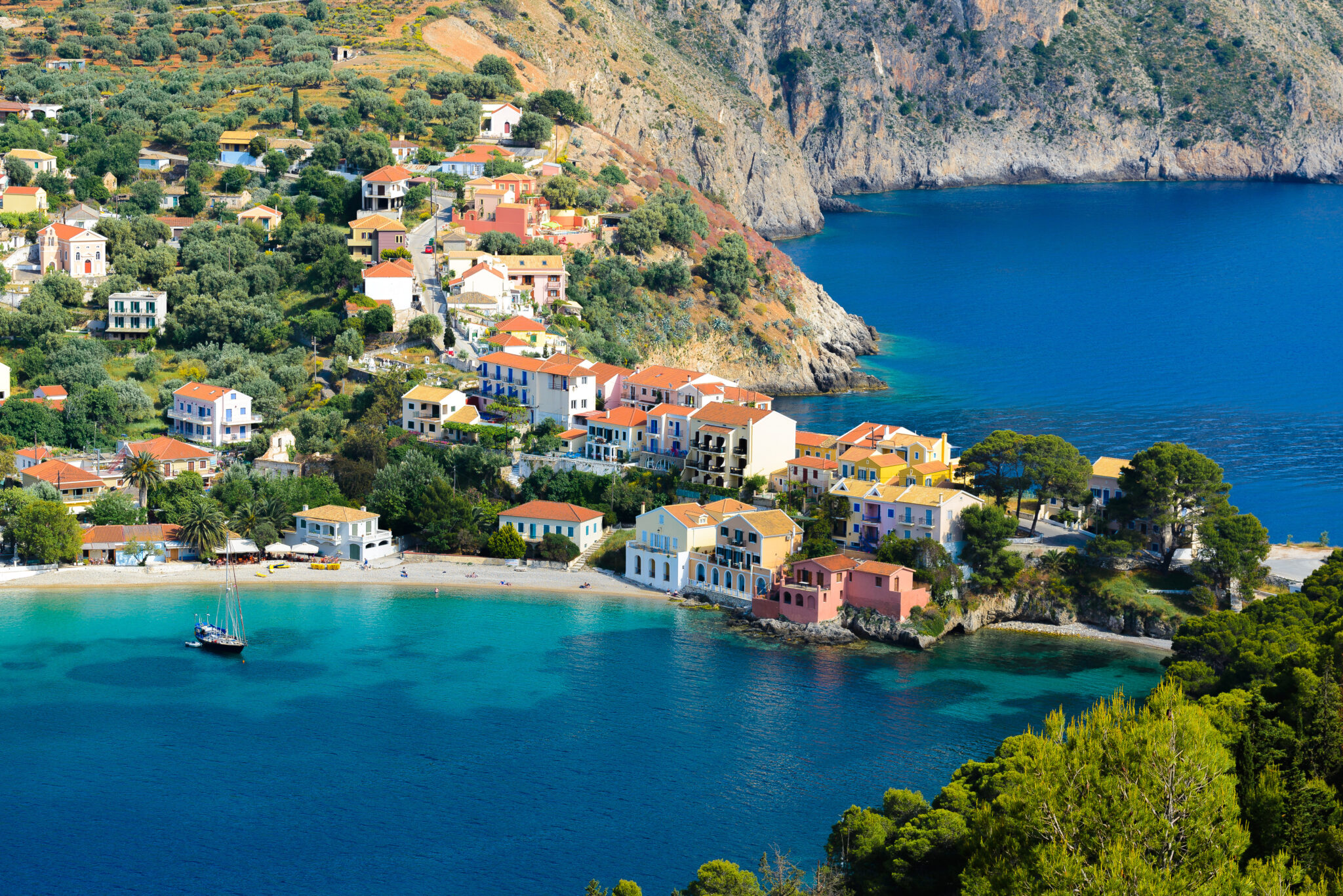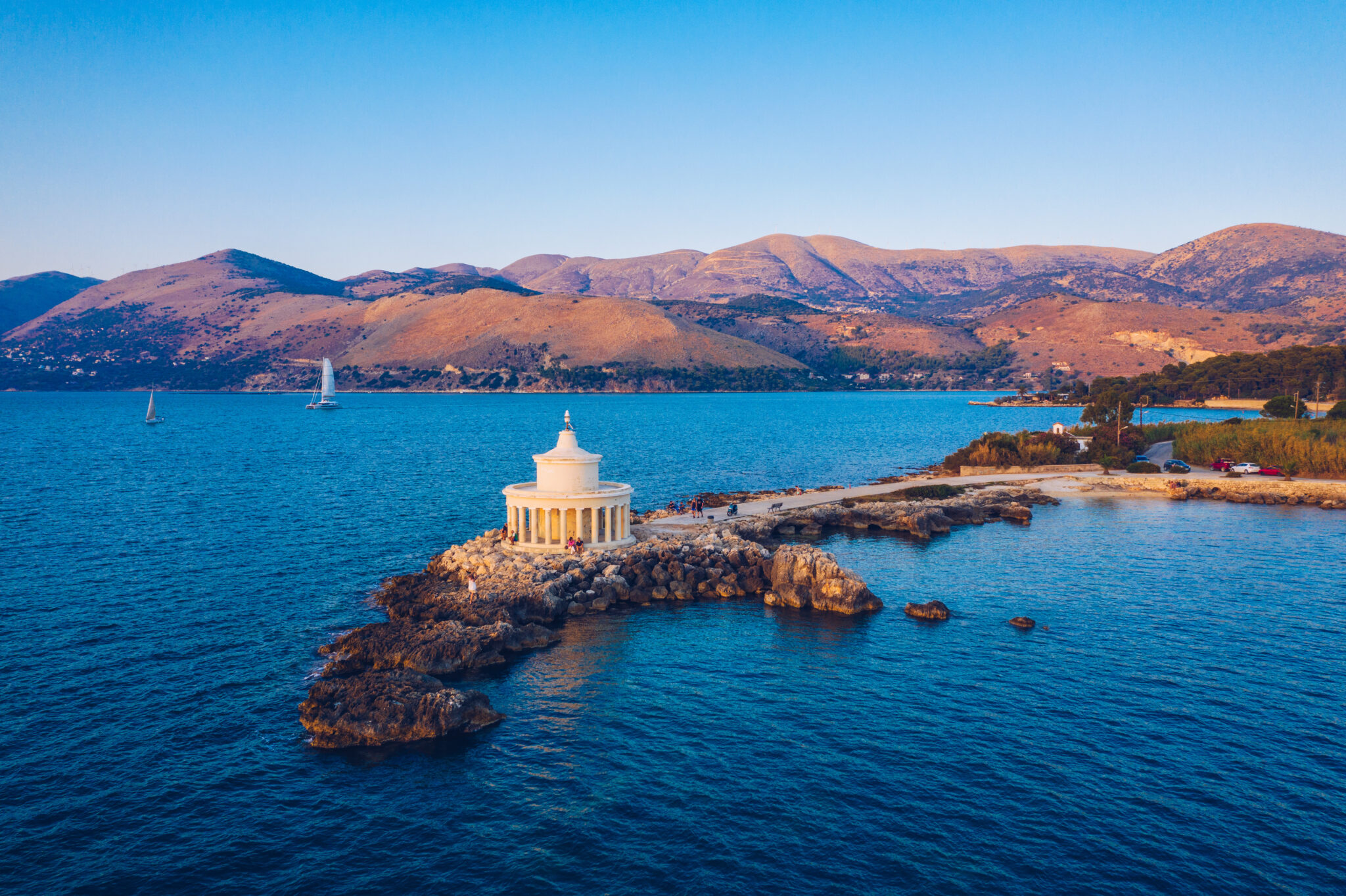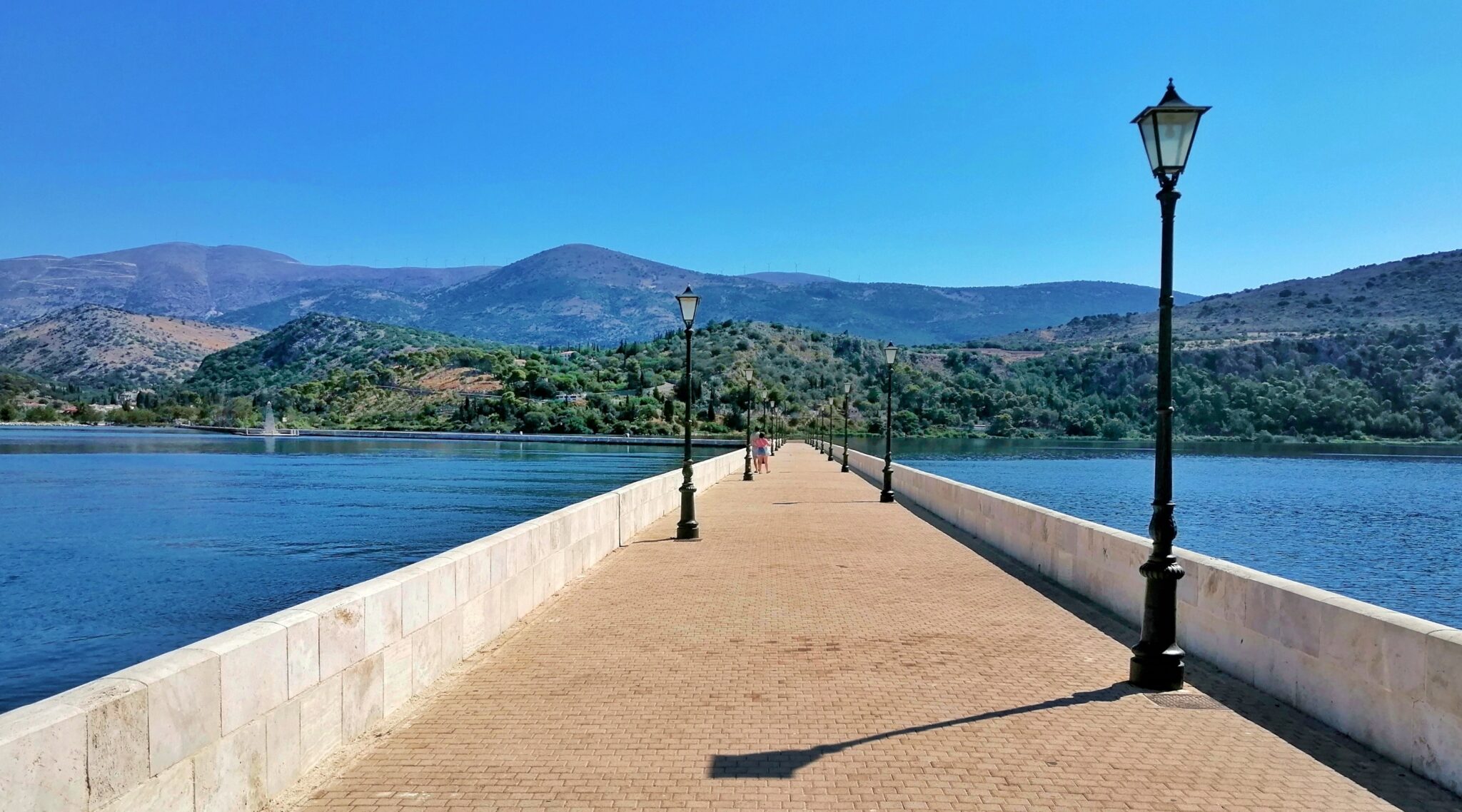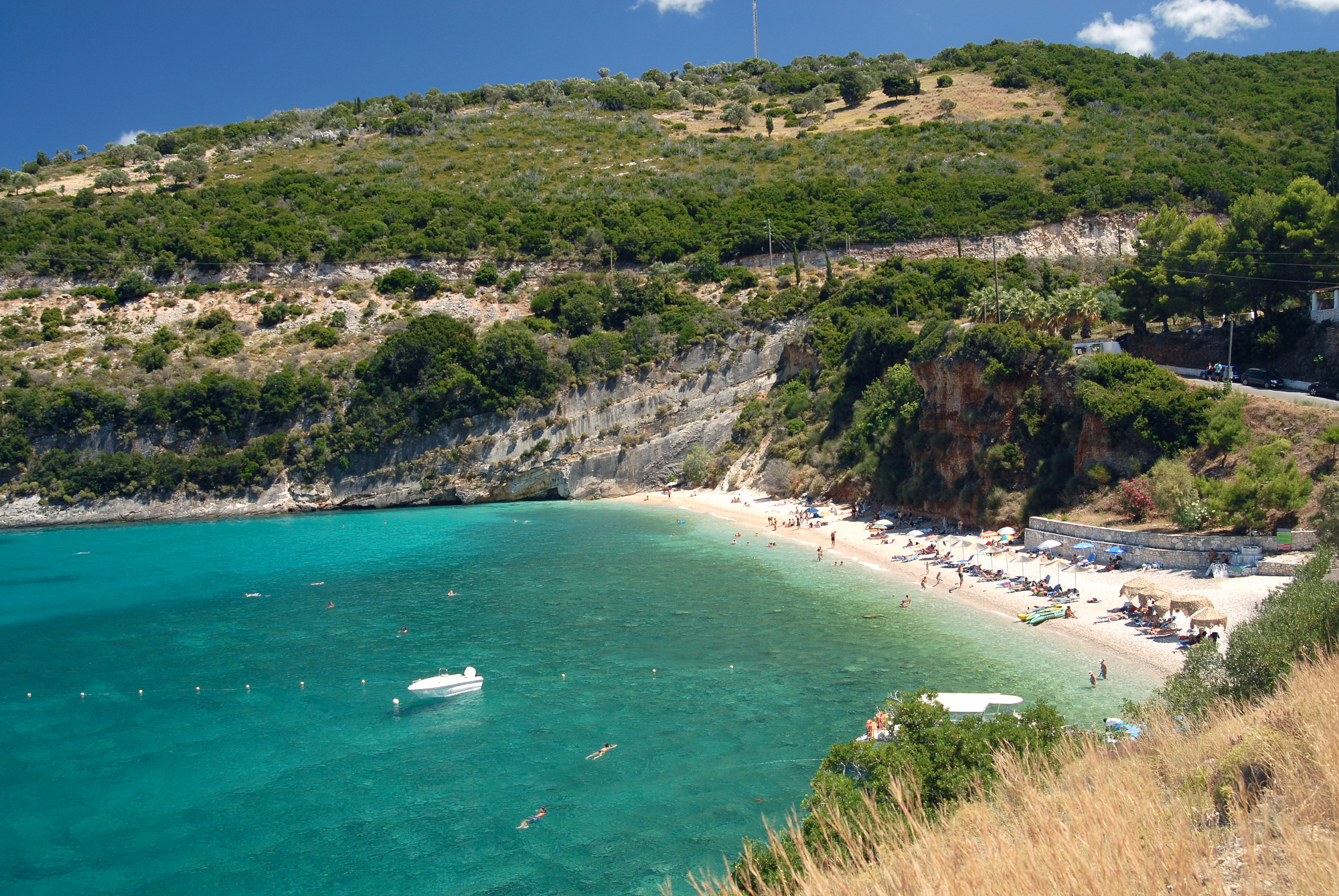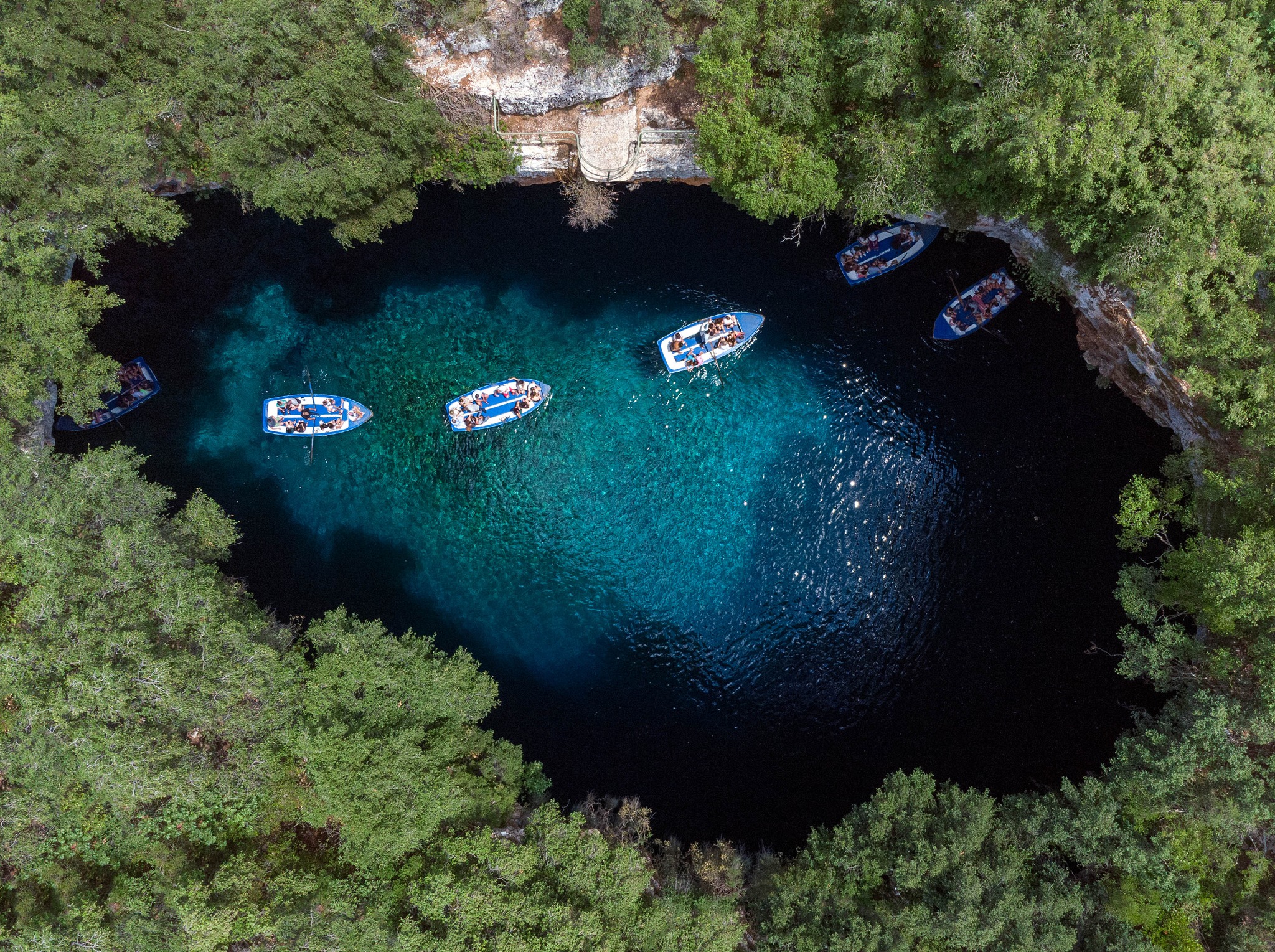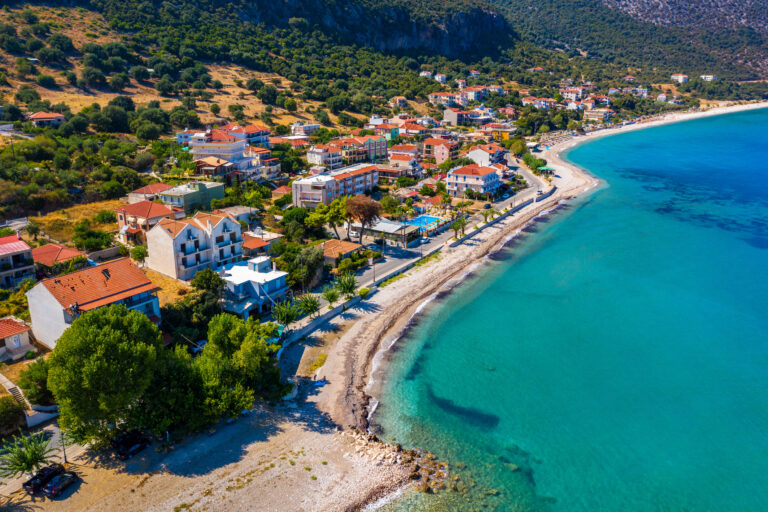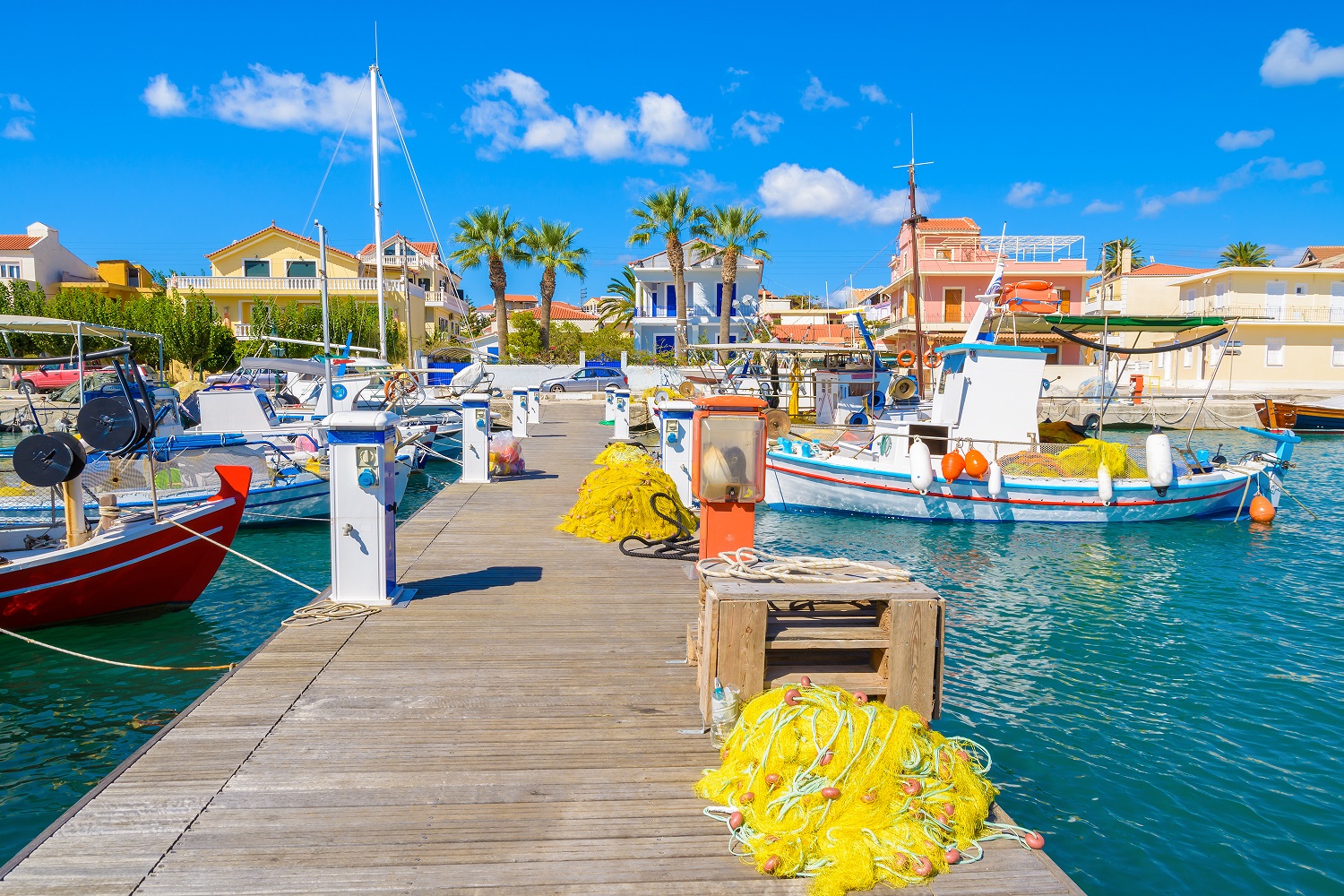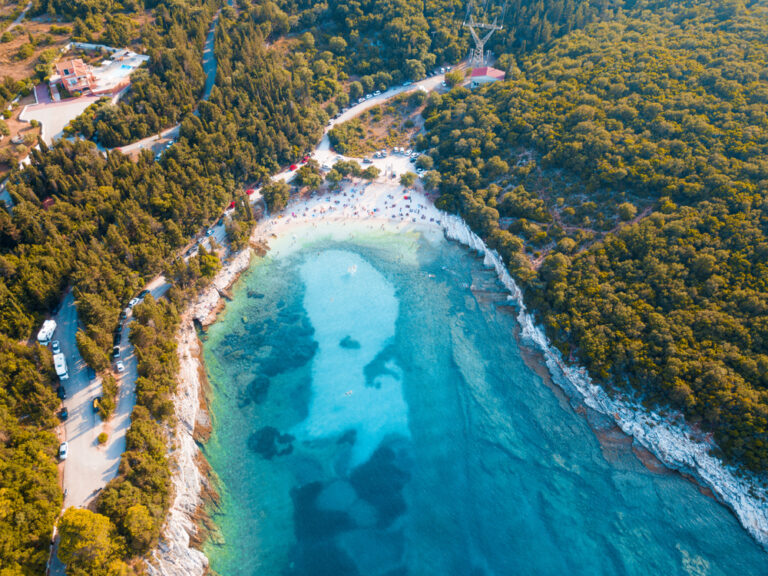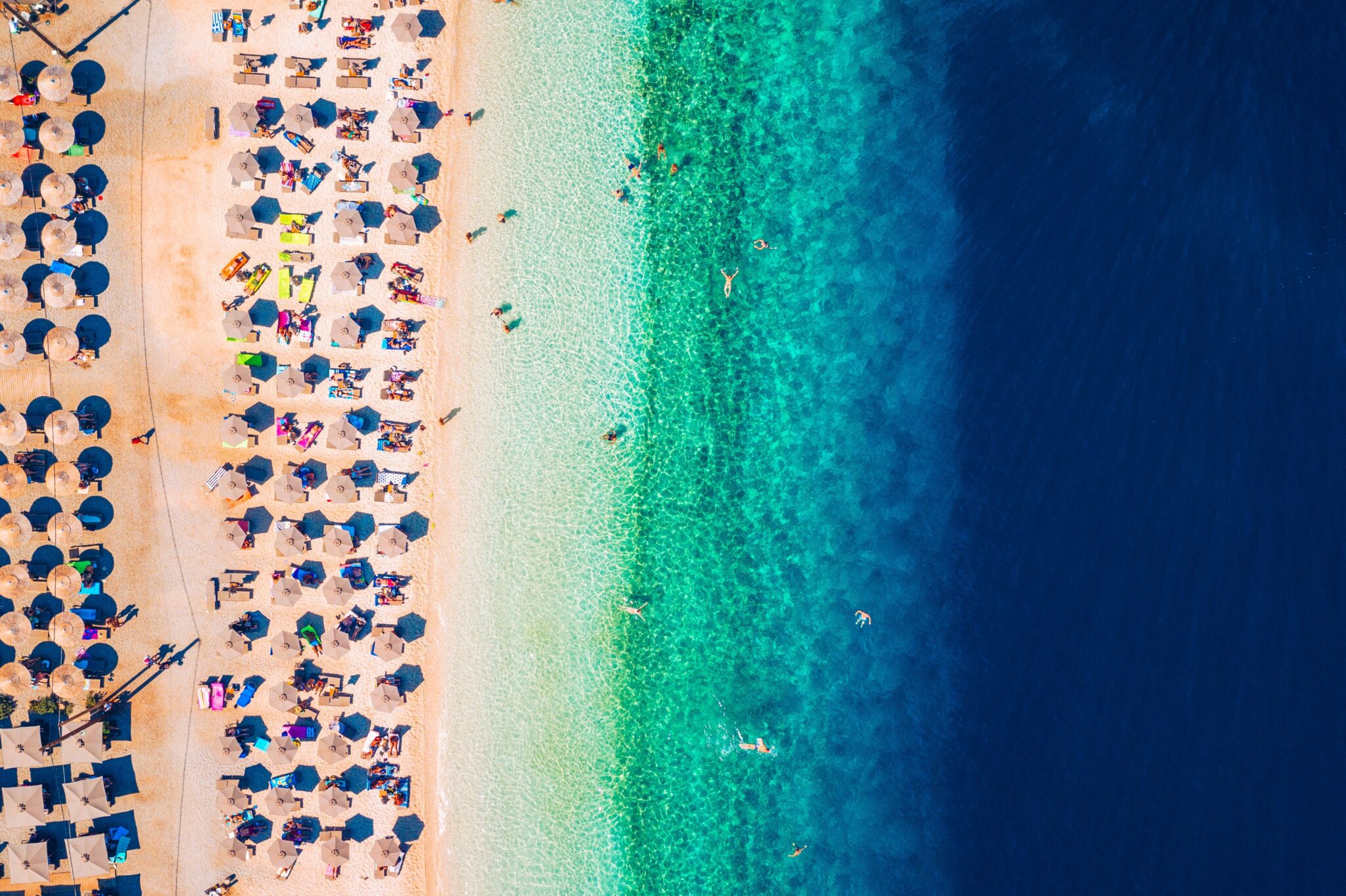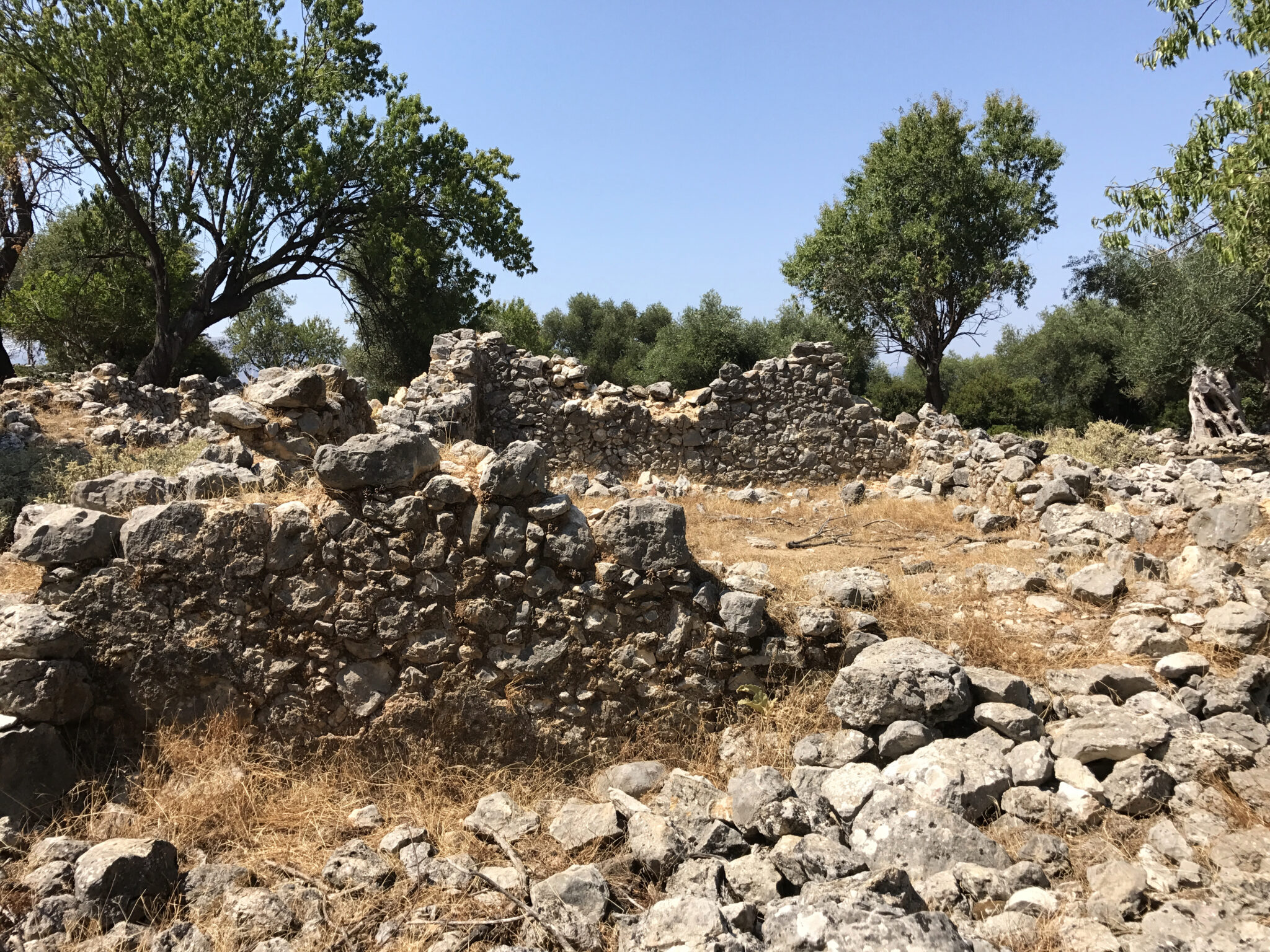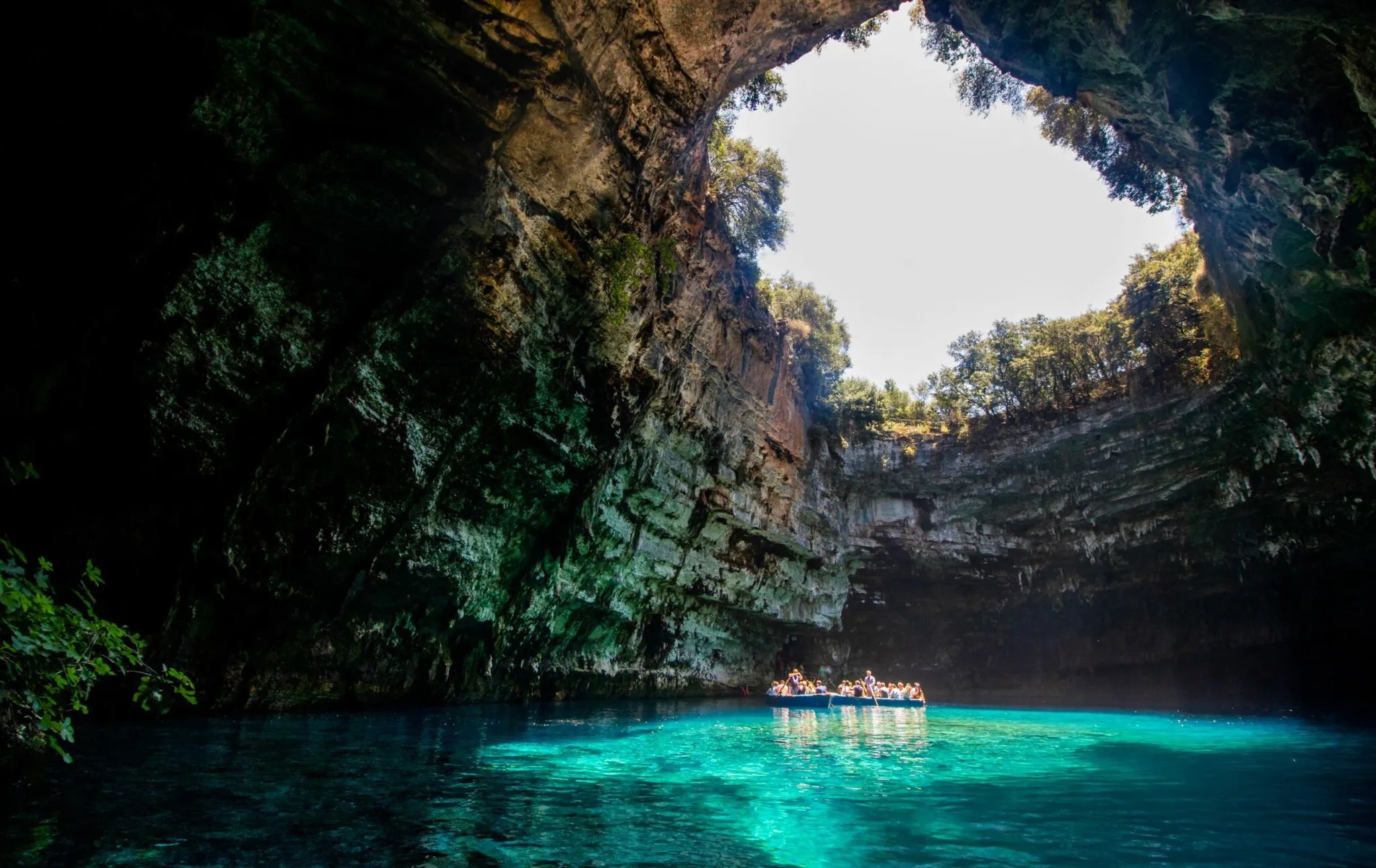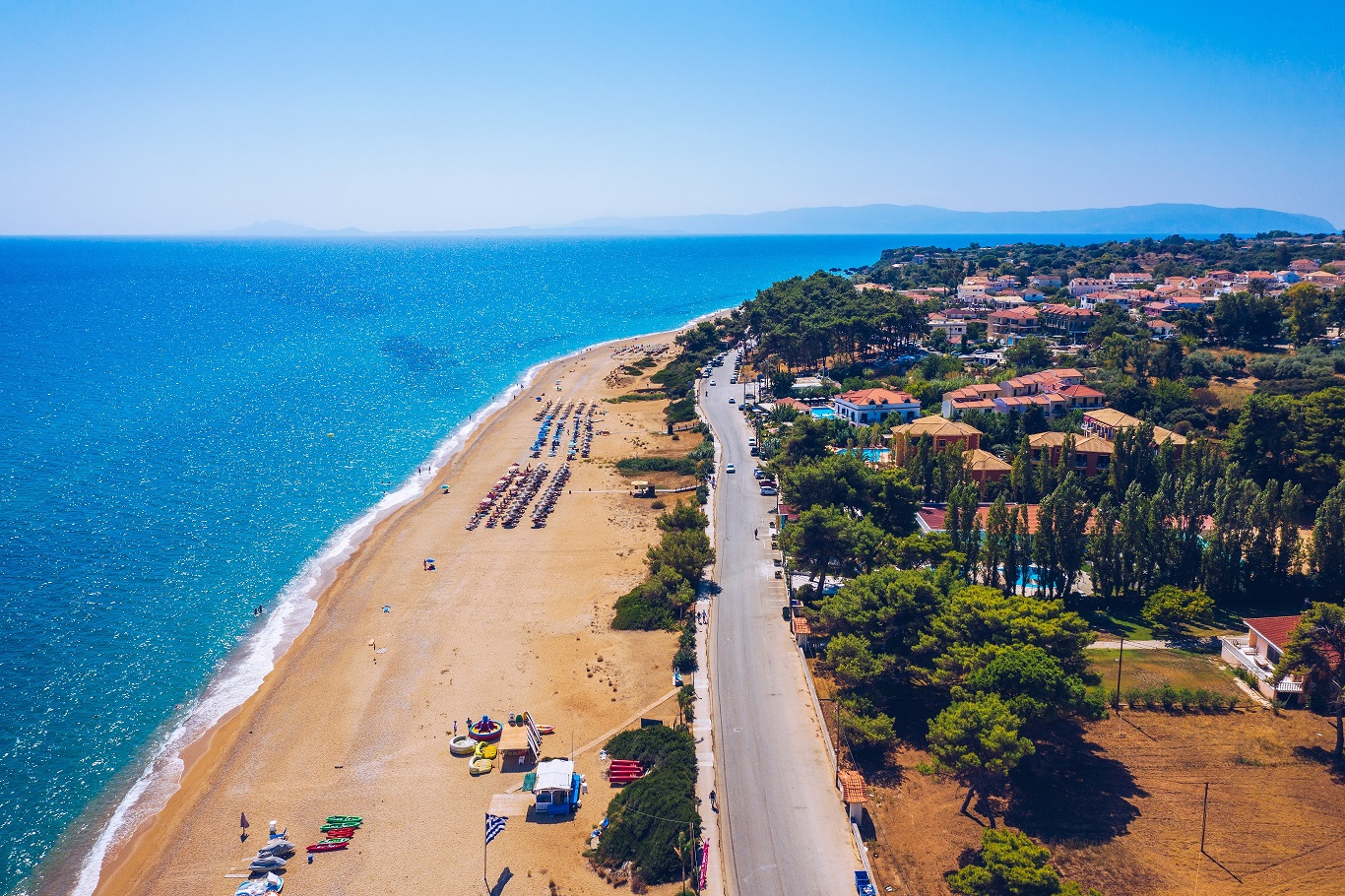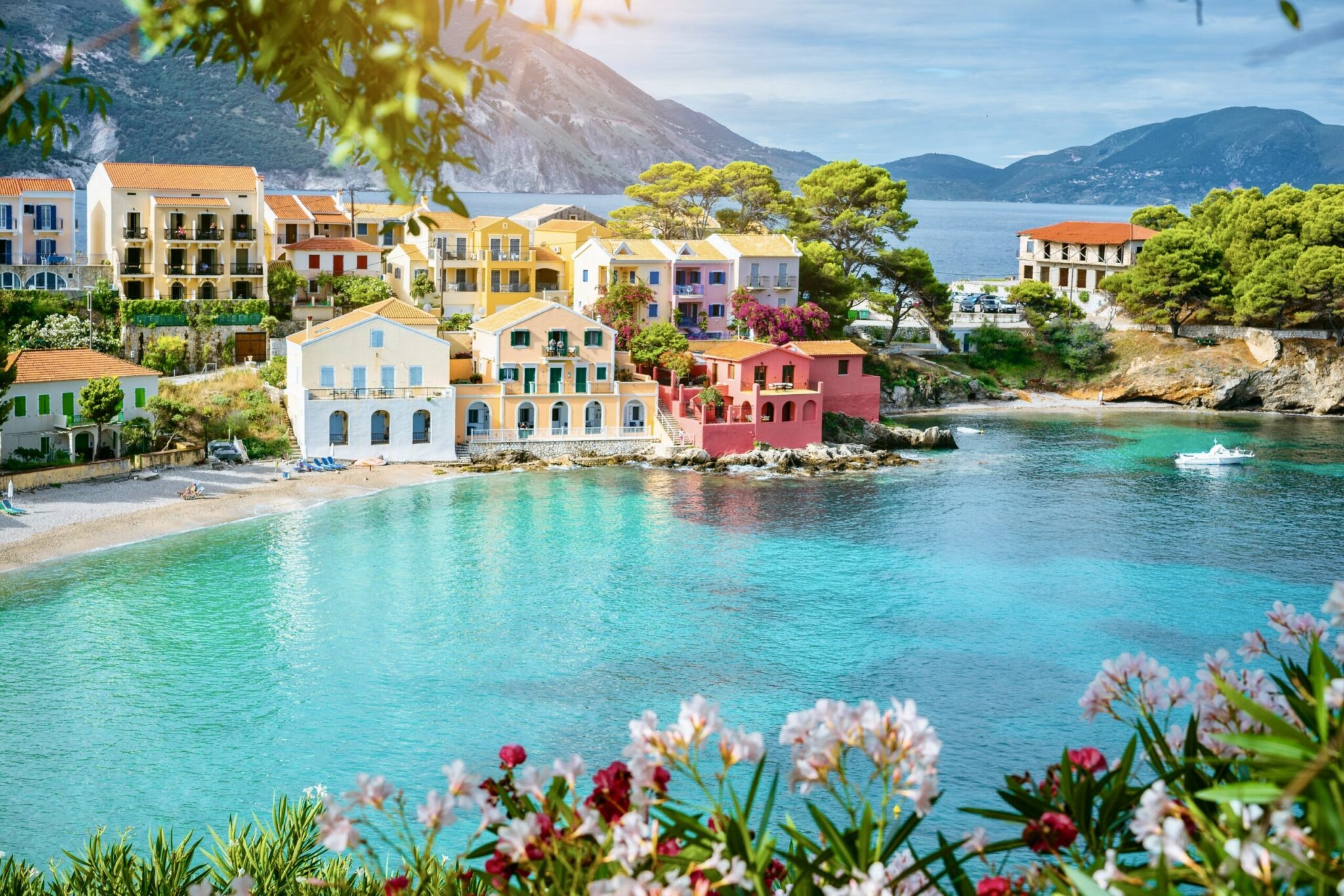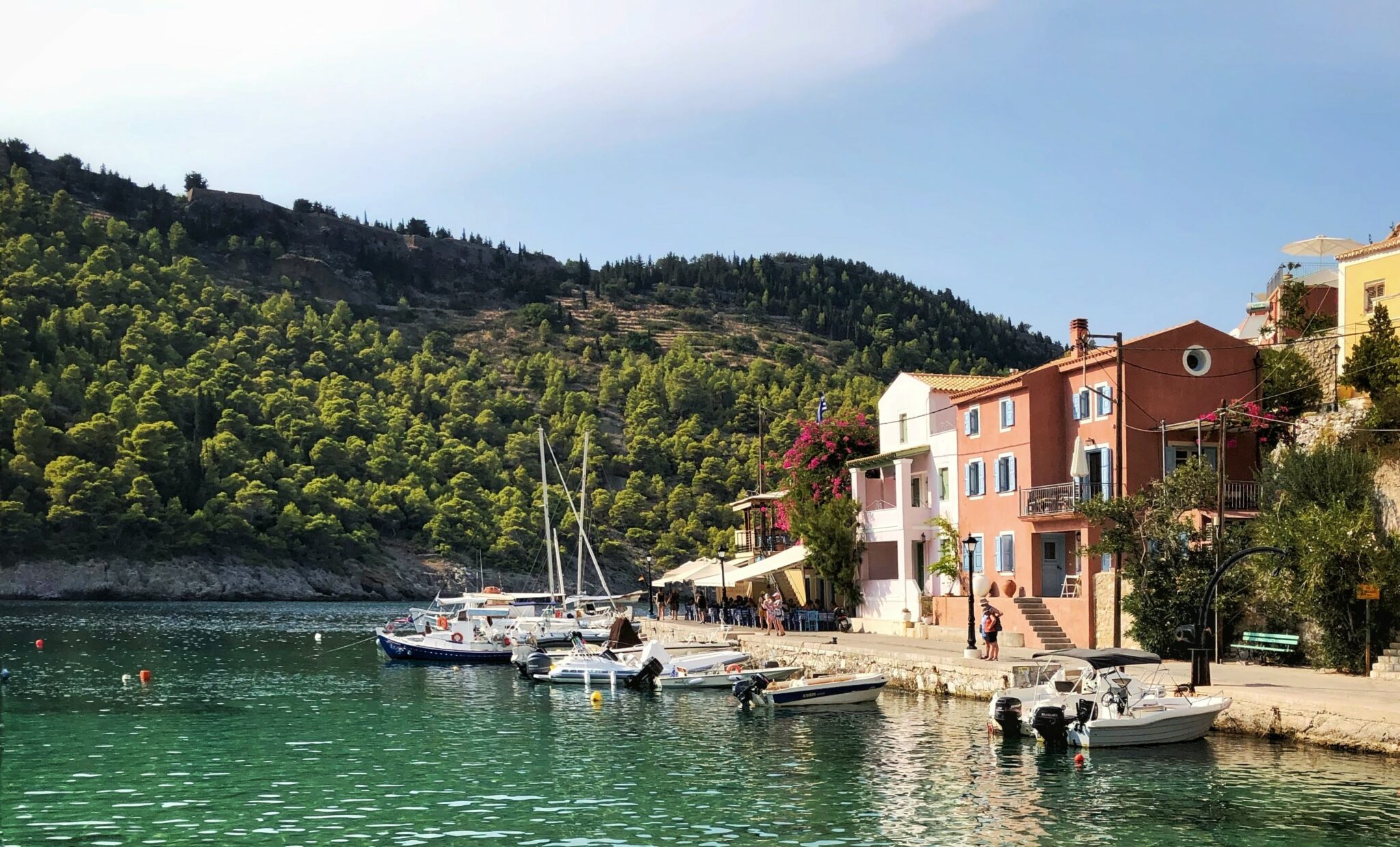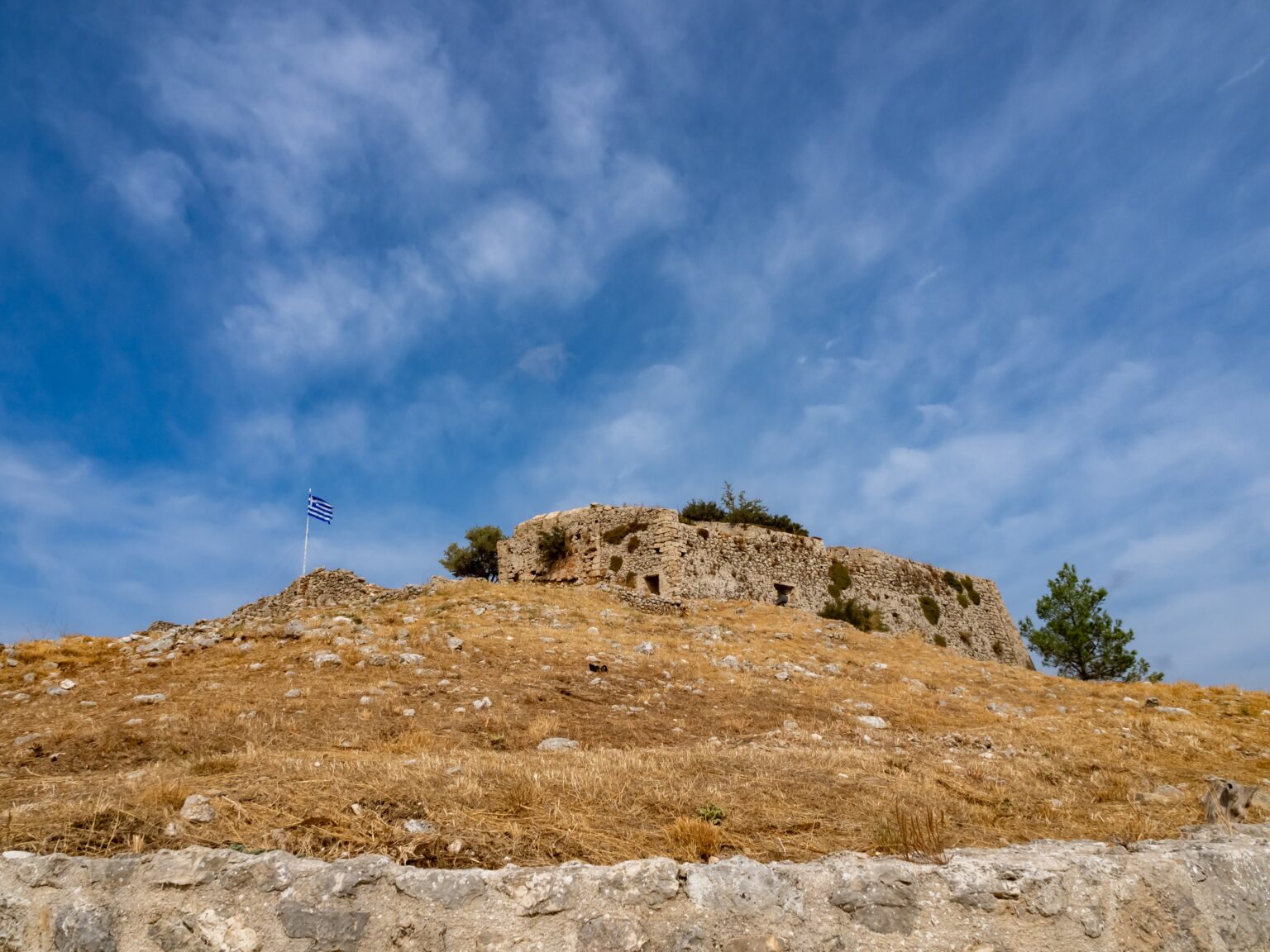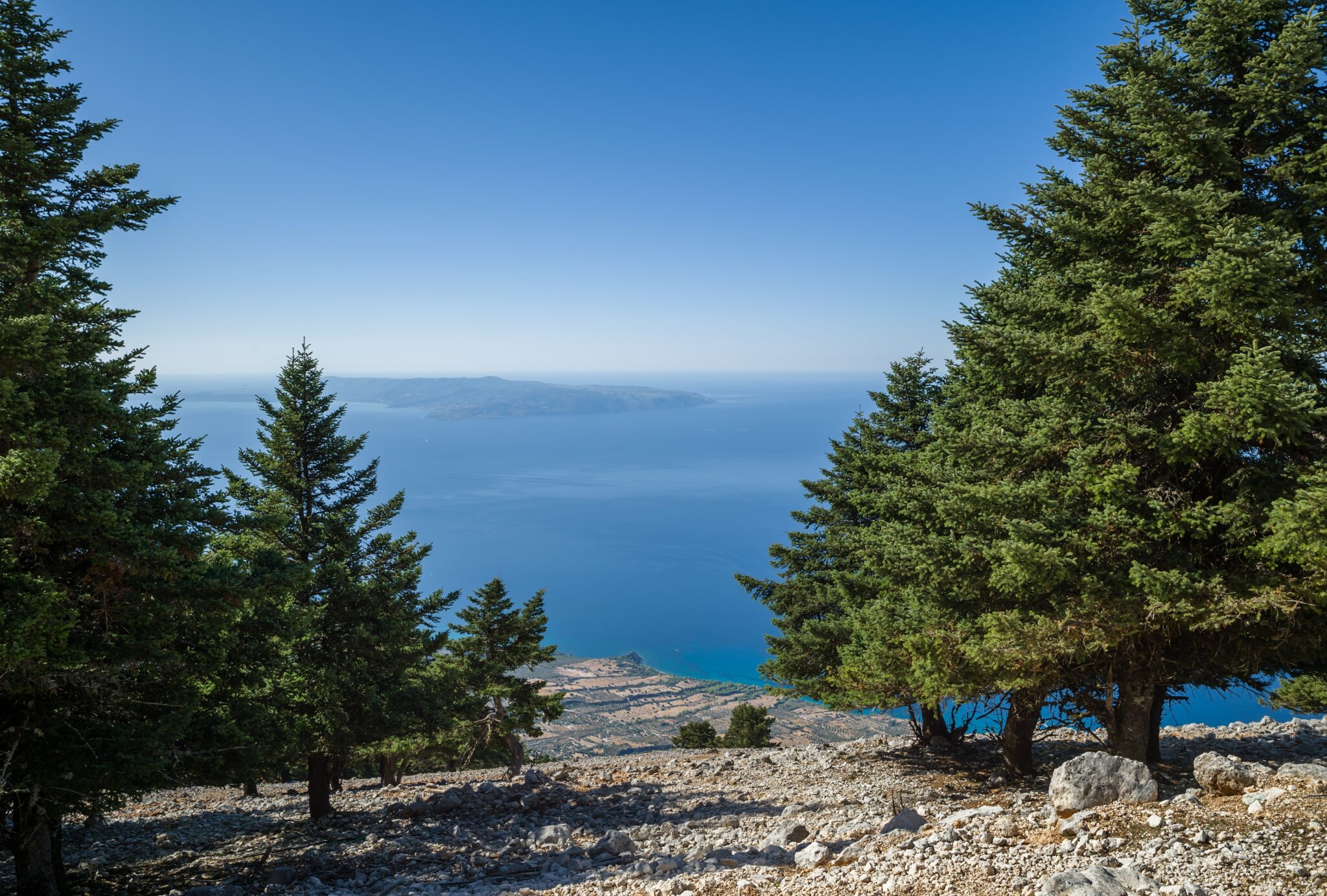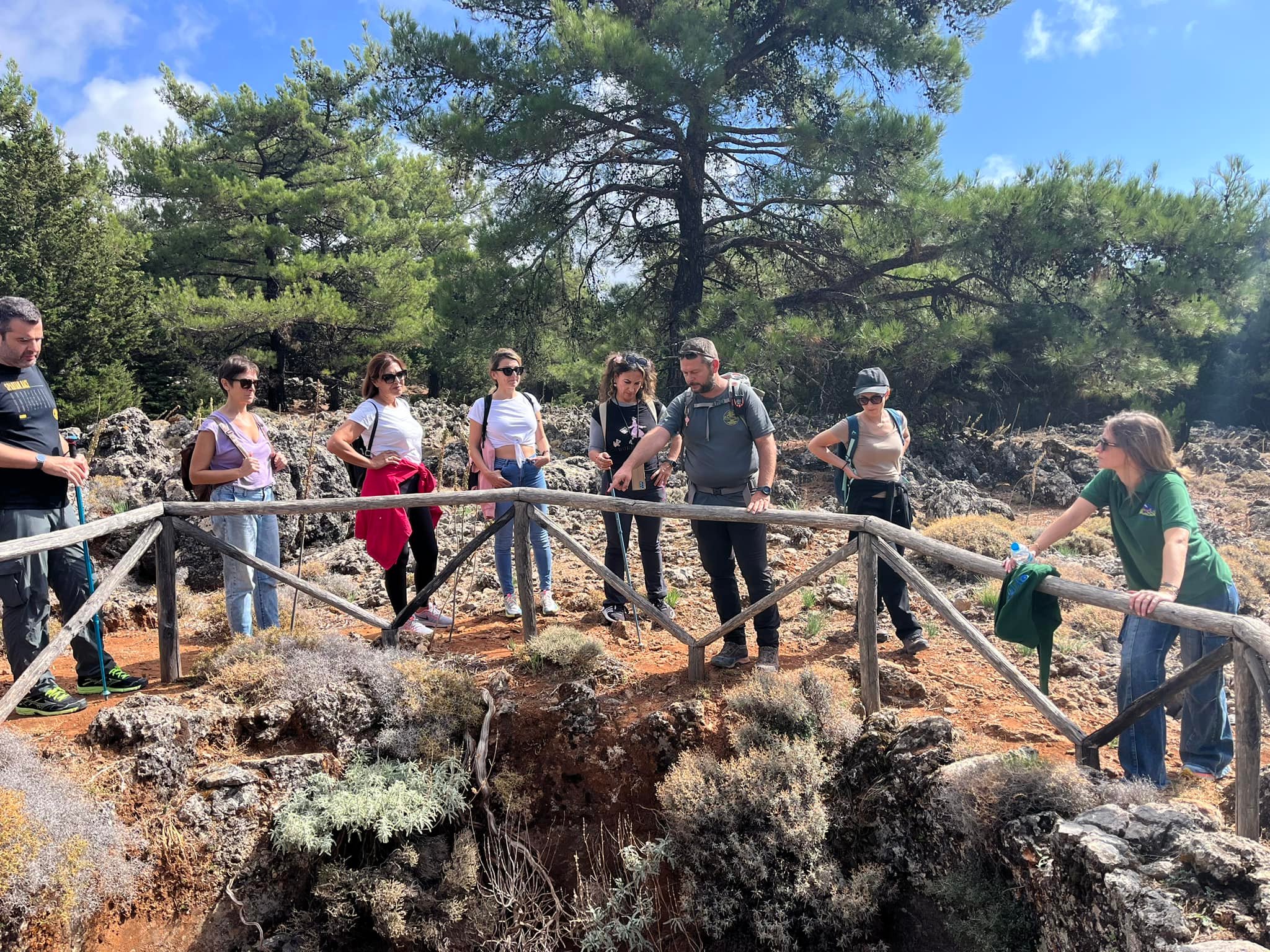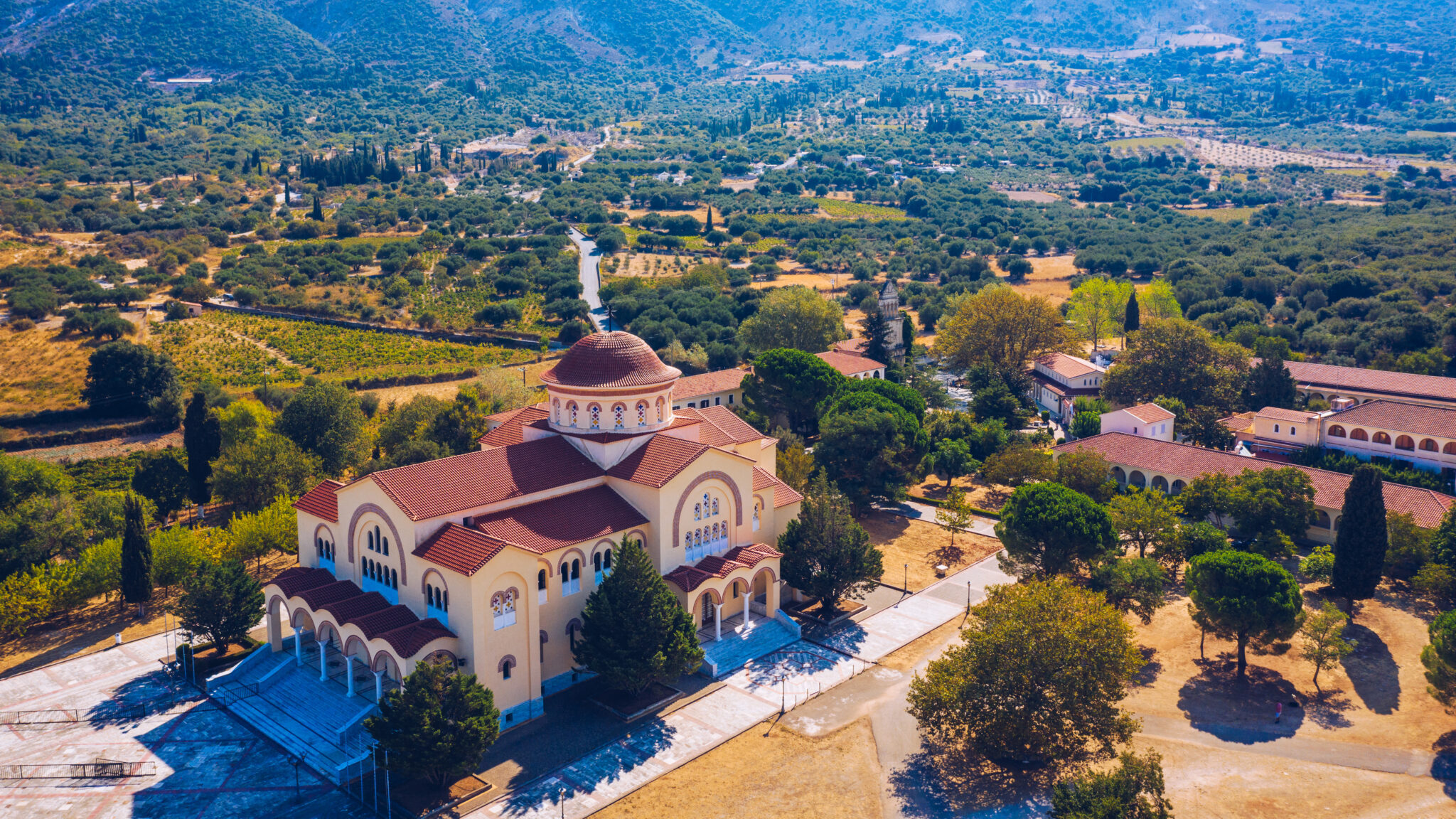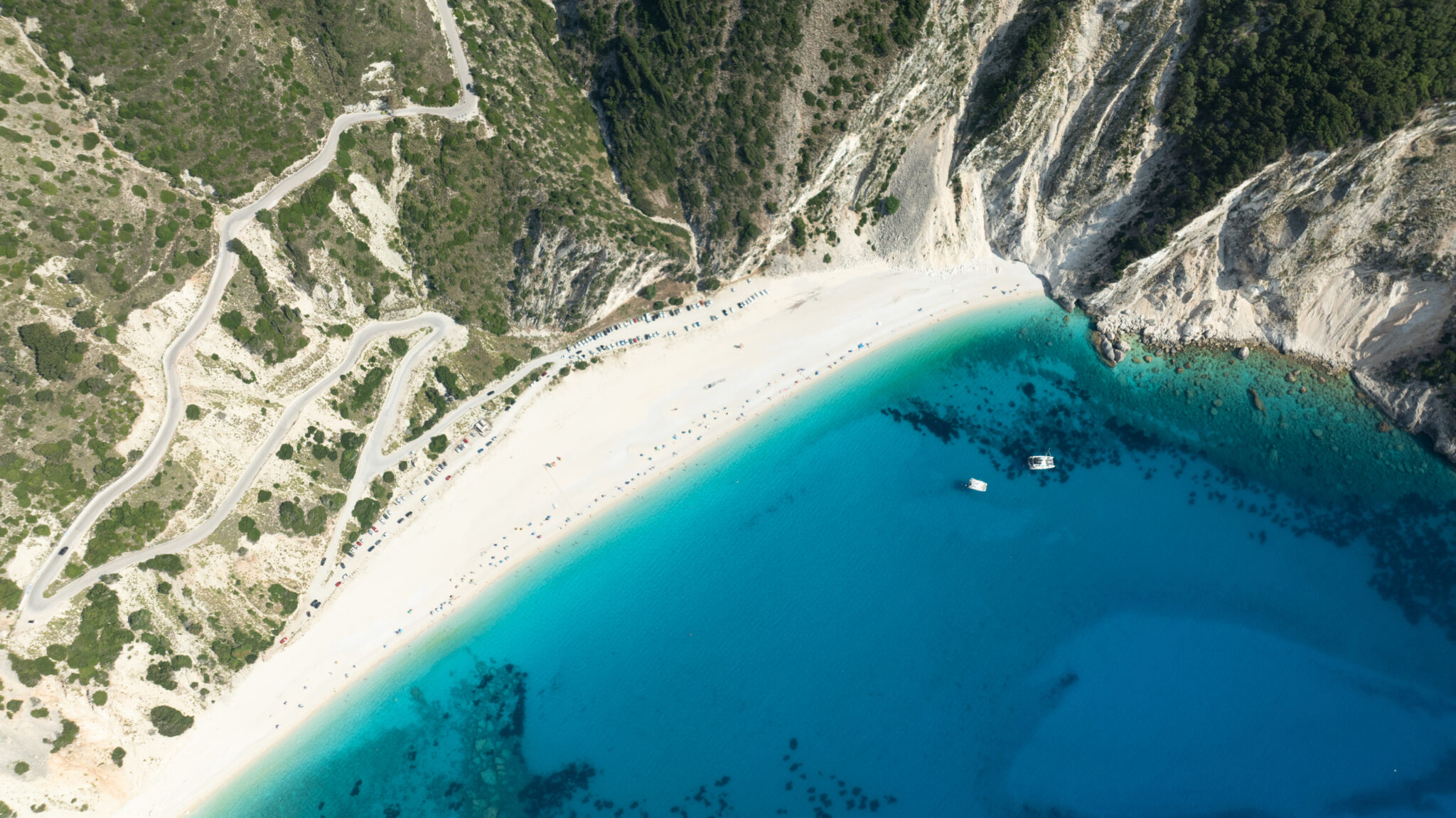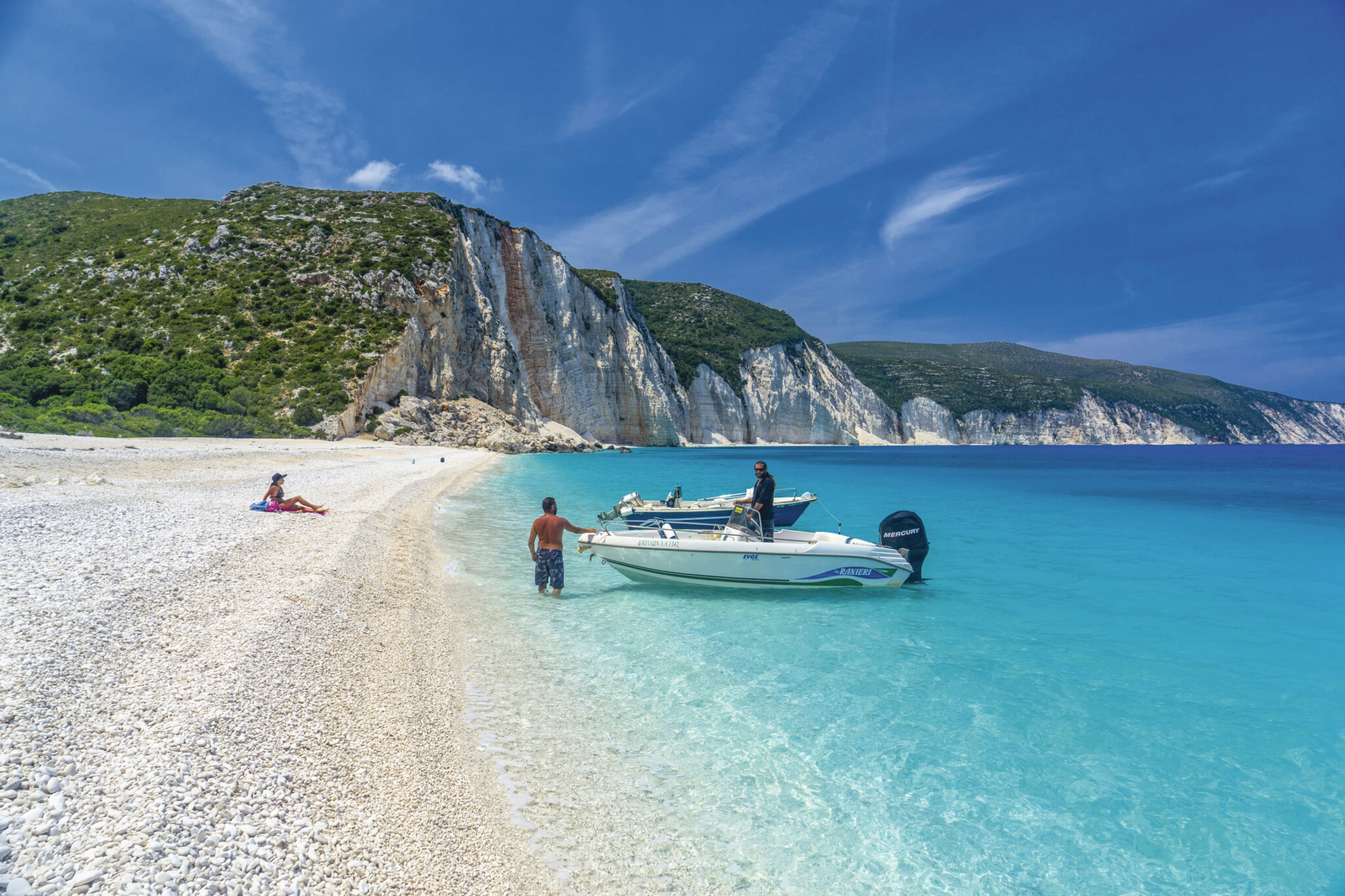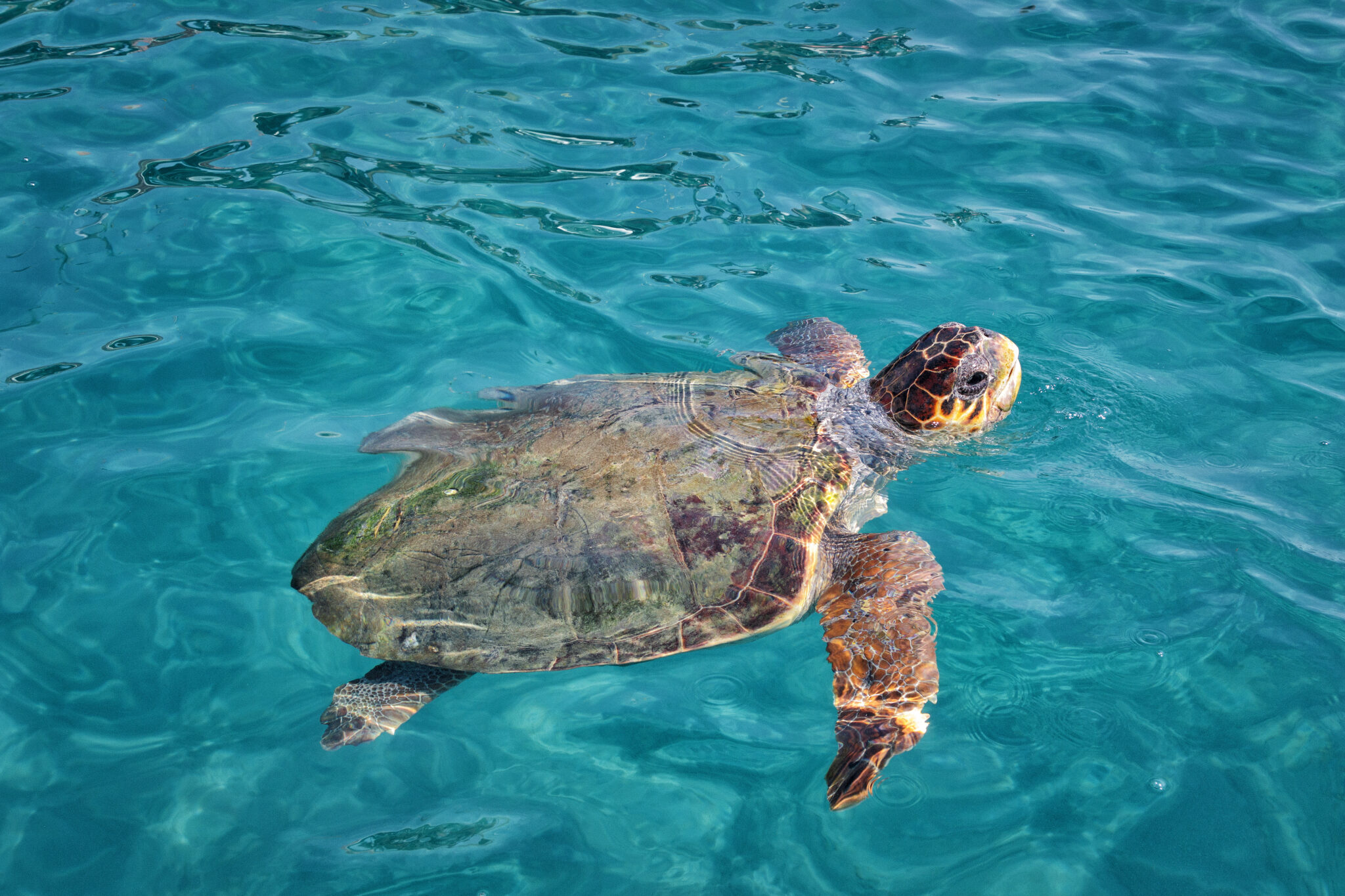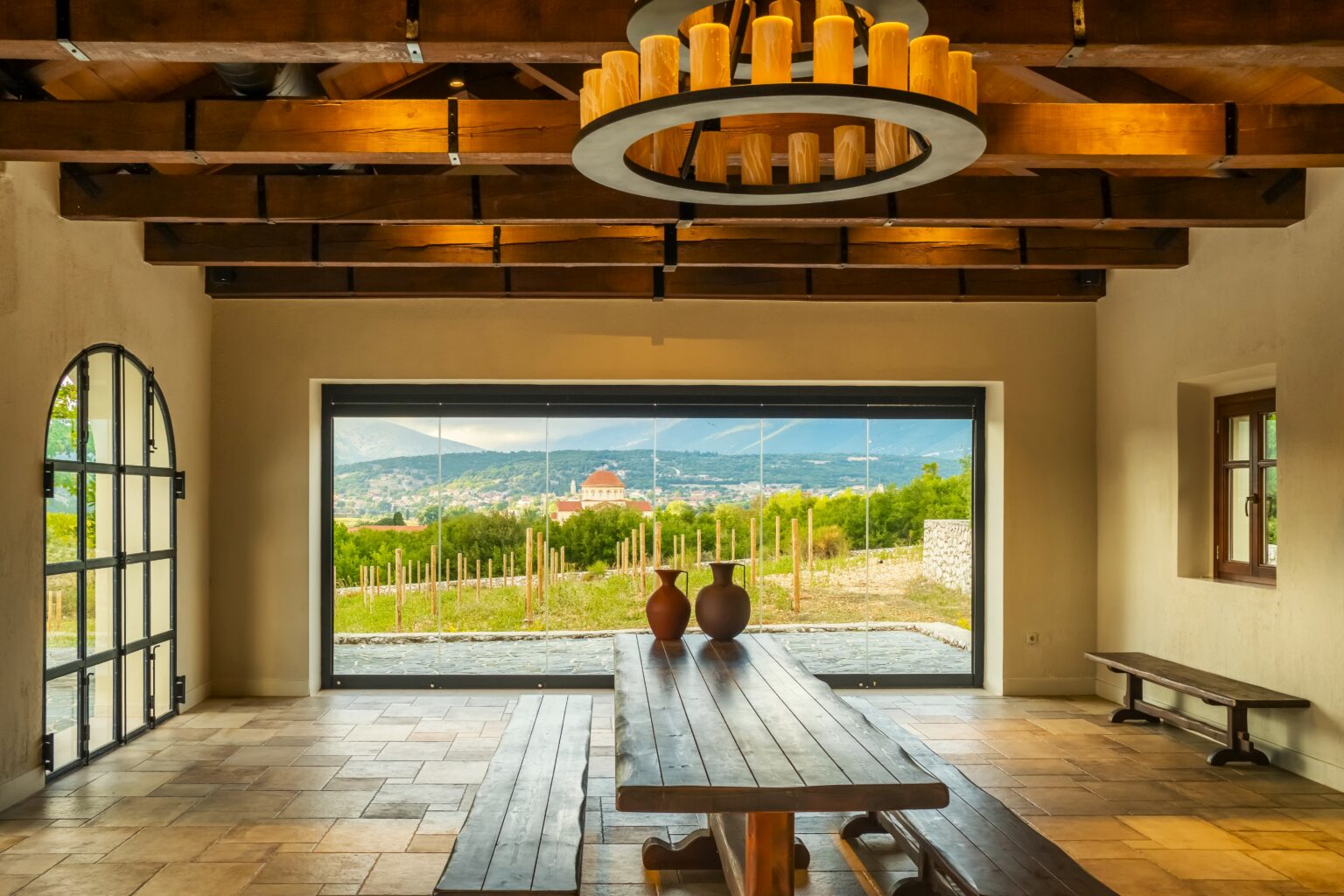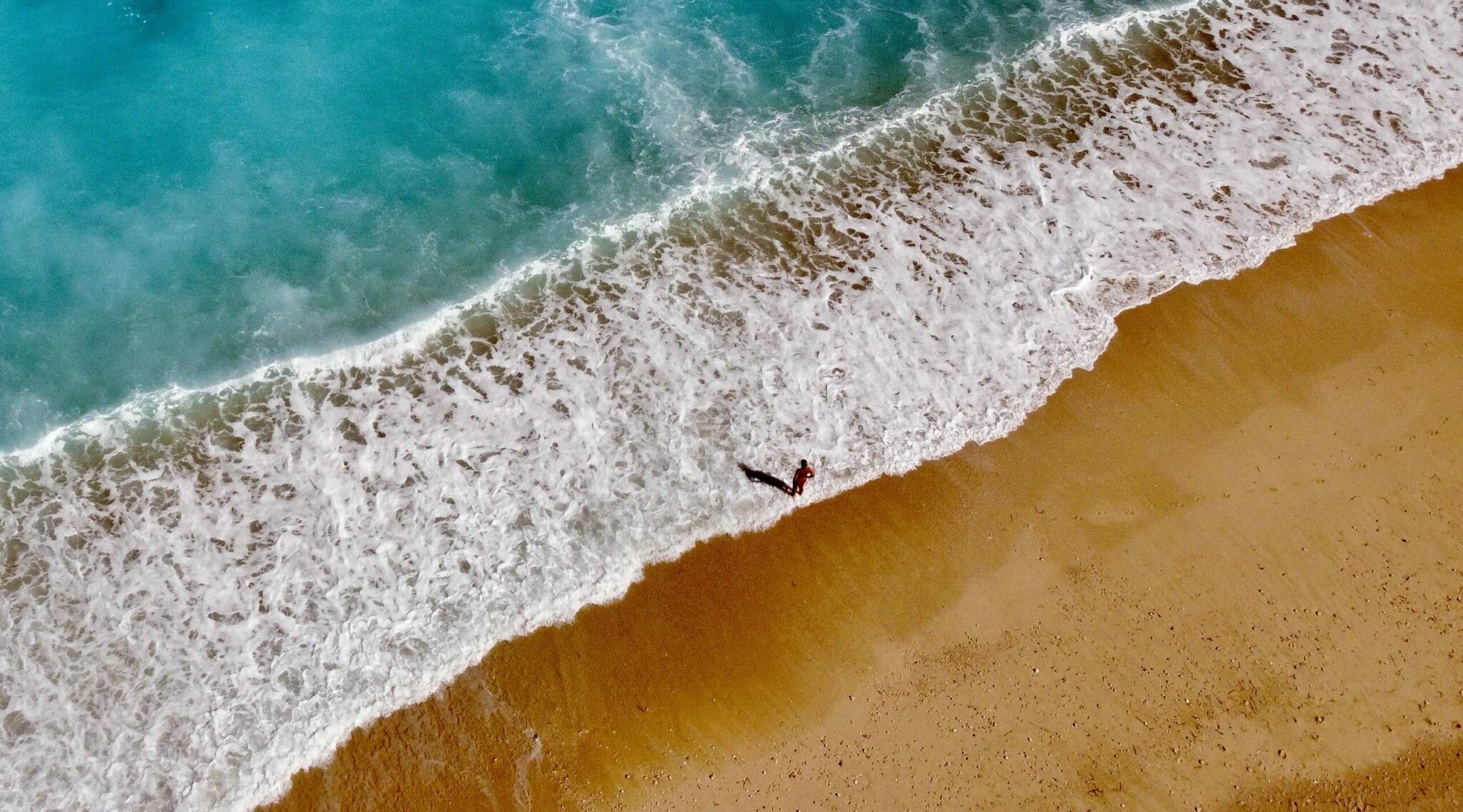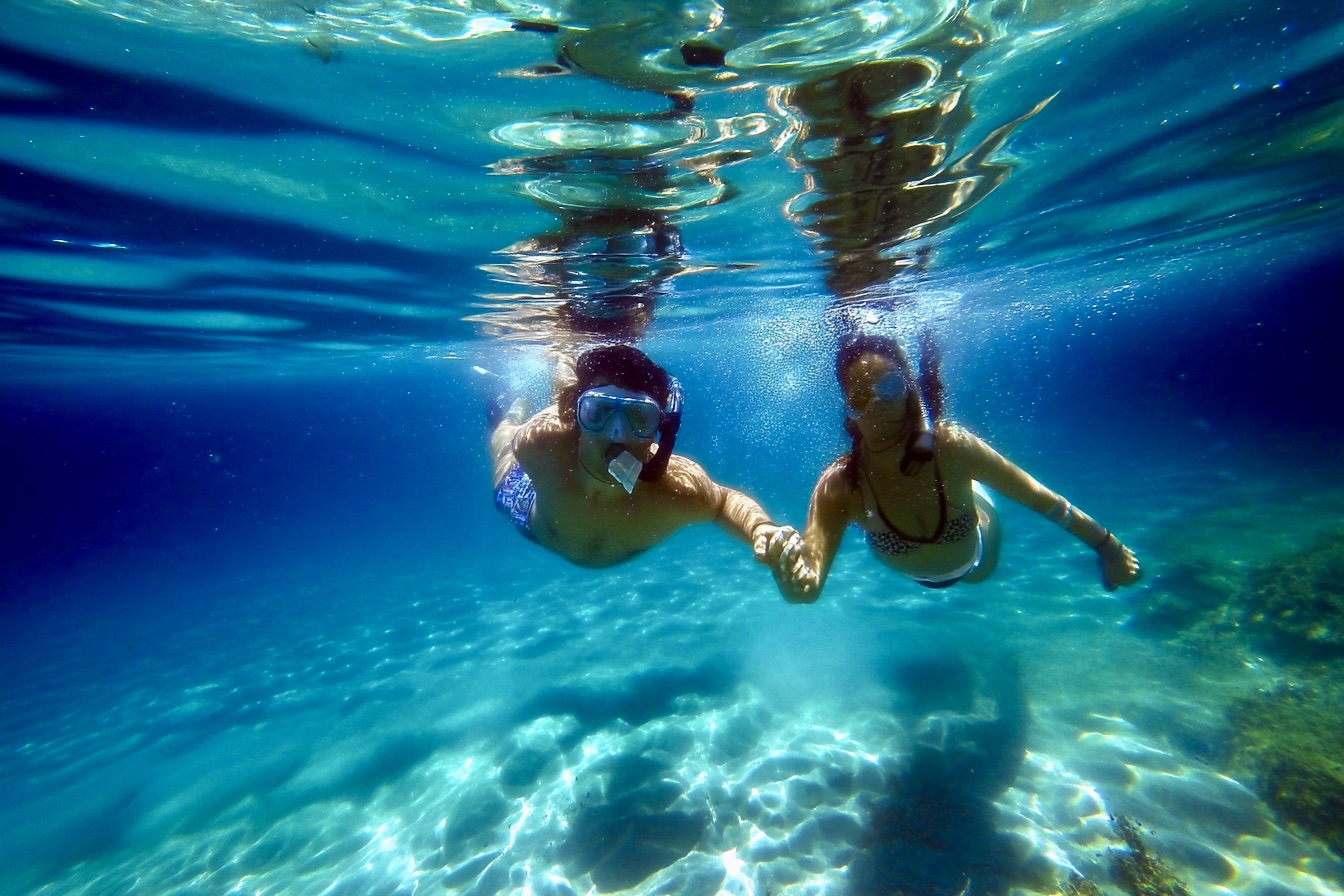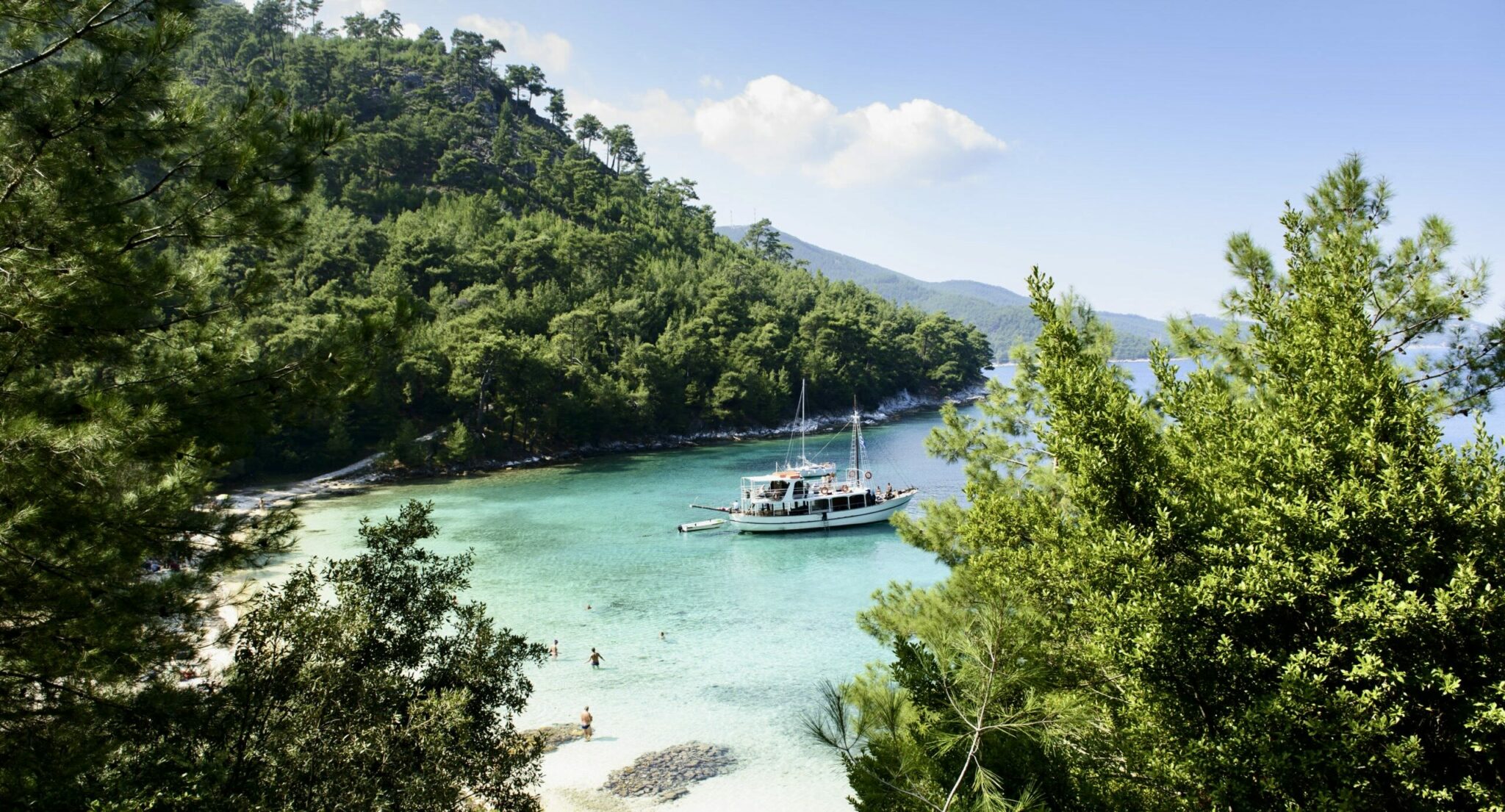Kefalonia doesn’t announce itself so much as unfold – each switchback revealing another register of blue, another layer of history. The island’s spine, Mount Ainos, rises in a sweep of endemic black fir, while below, Melissani’s subterranean lake shimmers like stained glass lit from within. Venetian fortresses still guard headlands tufted with cypress, and hilltop monasteries perfume the wind with frankincense and beeswax. Even the light seems stratified: a silver shimmer at dawn, a molten brass by late afternoon, the whole palette resetting each time the mistral shifts.
Yet Kefalonia is no museum piece. Argostoli pulses with fish-market banter and espresso steam, Assos wraps its pastel houses around a horseshoe bay like charms on a bracelet, and Fiskardo pairs super-yachts with fishing caiques as naturally as it mixes ouzo with gossip. Between them sprawl beaches that defy taxonomy – Myrtos’ marble shingle, Xi’s paprika sand, Dafnoudi’s seal-haunted grotto. What follows is a distilled roadmap to these contrasts and consonances, an invitation to read the island the way locals do: slowly, with all senses tuned to wonder.
Argostoli
Once dubbed the island’s finest settlement, Argostoli blossomed in the 18th century with a Renaissance-Baroque flourish. Though the 1953 earthquake reshaped it, the capital rebuilt itself into a vibrant town alive with palm-lined promenades, pedestrian lanes, lively squares, and a thriving café and nightlife culture. Highlights include the central square with the Vallianos statue, the Focas Cosmetatos Foundation Museum, and the Folklore Museum housed in the Corgialenios Library.
Wander through the neighborhoods dotted with tall church bell towers, early post-quake prefab homes, and newer buildings. The main pedestrian street, Lithostroto, starts at the courthouse and is lined with cafés, boutiques, and local shops. Here you’ll find the 18th-century gilded wooden iconostasis of Saint Spyridon Church, the Catholic Church of Saint Nicholas, and the restored bell tower in the historic Campana Square.
Koutavos Lagoon
As you enter Argostoli, the Koutavos Lagoon welcomes you with lush greenery and an elegant statue of a local political figure. The seafront road has a long pedestrian promenade that leads past the town’s swimming pool and the Merchant Marine Academy, marking the start of the scenic Lassi route. From here, you can also cross the Drapano Bridge toward the villages and roads leading to Lixouri, Fiskardo, and Sami.
What was once a swamp has been transformed into a verdant haven with flowing waters, swans, wild ducks, and other birdlife. Midway through the path, you’ll reach the hill of ancient Krani, where the ruins of cyclopean walls and a Doric temple dedicated to Demeter still stand. An abandoned mill marks the location of Myloi, and to the north lies the chapel of Saint Barbara, offering panoramic views of Argostoli.
Lassi Circuit
No visit to Kefalonia is complete without a drive or walk around Lassi. Home to upscale hotels, excellent restaurants, and beautiful beaches like Makris Gialos and Platis Gialos, the area combines natural beauty with historical intrigue. You’ll pass by the Katavothres—natural sinkholes where seawater disappears underground—and the iconic Lighthouse of Saint Theodoroi, a whitewashed structure with 20 Doric columns and a small tower, rebuilt after the earthquake. Higher up, you’ll find the Italian War Memorial, honoring the 10,000 soldiers of the Acqui Division killed in 1943 while resisting the Nazis. The route continues through pine groves and tiny beaches before looping back to Argostoli via Pharaoh Hill.
Katavothres (Sea Mills)
First discovered in 1835, these natural sinkholes draw seawater into underground channels, eventually resurfacing 15 km away at Melissani Lake. This unique geological phenomenon remained a mystery until 1963, when scientists used dye-tracing to uncover its subterranean path.
Poros
Poros gazes out to the Ionian and rests against a backdrop of lush, forested mountains. Its most striking natural landmark is the narrow Poros Gorge—often called the “Little Tempi” for its sheer vertical cliffs rising up to 80 meters. In winter, the gorge fills with the rushing waters of the Vochinas River, which flows into the sea. In summer, Poros Beach is a popular destination for crystal-clear swimming, and remarkably, even the waters beside the ferry dock remain pristine.
Poros has long held strategic and historical significance. In antiquity, it served as the port of the fortified city of Pronnoi. High above, at Paleokastro (elevation 545 m), lie the remnants of its classical acropolis. Nearby, in the village of Tzanata, archaeologists unearthed a large Mycenaean tomb. More recently, excavations in the Drakaina Cave within the gorge revealed prehistoric finds, adding further depth to the area’s cultural layers.
In 1821, the British Commissioner Charles Napier settled Maltese families here, calling it “New Malta.” Though the area was eventually abandoned, it was resettled after the 1953 earthquake by villagers whose homes had been destroyed. Today, Poros is a lively coastal hub with hotels, tavernas, an open-air amphitheater, and a central square that remains the heart of community life.
Korgialenios Library
Founded in 1924 through the bequest of island benefactor Marinos Korgialenios, the Korgialenios Library merged with the earlier Public Library of 1887. It houses a notable collection of Ionian literature, Kefalonian newspapers dating back to 1849, and rare manuscripts, including Byzantine musical texts.
Since 1971, the museum on the ground floor of the neoclassical building has showcased Kefalonia’s cultural history—from the Venetian era (circa 1500) to the devastation of the 1953 earthquake. Through exhibits on daily urban and rural life, traditional dress, folk and ecclesiastical art, and pre-quake architecture, the museum honors the island’s rich heritage and key local figures.
Lixouri
Despite the transformations after the 1953 earthquake, Lixouri still radiates the charm of its aristocratic past. Landmarks like the Iakovateios Library and the Geroulanos Mansion—home to a room honoring local saint Panagis Basias—anchor its identity. Throughout the town, statues, busts, and the lively exchanges of locals give it a distinct character.
Though traditional serenades are rarer today, you might still hear them drifting from a tavern. Visit the churches of the Holy Trinity and Saint Nicholas of Miniates, and don’t miss the local delicacies—fig tart (sykomaïda) and honey-almond bars (barboule) handmade by the women’s cooperative.
The Kounopetra Mystery
Kounopetra, in the Akrotiri area of southern Paliki, is one of Kefalonia’s most intriguing geological phenomena. For centuries, this massive coastal rock was observed to move slowly and continuously—visible to the naked eye—though scientists were long unable to explain why.
After the 1953 earthquakes, the rock’s motion became barely perceptible. Recent studies suggest its movement was caused by unstable rock formations beneath it, combined with the effects of wind and sea. Though the mystery has been largely unraveled, Kounopetra remains a fascinating stop for travelers drawn to nature’s oddities.
Fiskardo
Fiskardo, the birthplace of poet Nikos Kavvadias, was miraculously spared from the 1953 earthquake and remains one of Kefalonia’s best-preserved traditional villages. Its colorful 18th- and 19th-century mansions, intact Venetian architecture, and vibrant harbor have made it a magnet for upscale travelers since the 1970s.
Stroll its cobbled lanes, browse boutique shops, or dine harborside on fresh seafood and lobster pasta. A coastal trail leads to twin lighthouses and the ruins of a Byzantine basilica, while archaeological finds include Roman baths and carved sarcophagi. Nearby beaches like Foki and Emblisi offer clear waters, smooth pebbles, and serene coastal beauty.
Agia Efimia
At the heart of the Pylaros region, Agia Efimia is a charming and well-planned coastal town known for its elegant architecture, inviting cafés and tavernas, and sweeping views of Ithaca. Named after the church at its entrance—rebuilt with French aid after the 1953 earthquake—the town retains some pre-quake buildings that hint at its past as a major trading hub.
Its harbor remains a favorite for yachts and sailing boats. Visitors can rent a boat to explore nearby beaches or swim in natural rock pools along the scenic coast to Karavomylos. Don’t miss the Church of Saint Nicholas, whose ornate iconostasis is housed in the Byzantine Museum of Athens.
Sami
Nature has been especially generous with Sami—Kefalonia’s main and most international port—blessing it with lush vegetation and rare natural wonders like the Melissani Lake Cave and the Drogarati Cave. Despite its deep historical roots, Sami is also a modern town, lined with shops, cafés, and restaurants along its busy waterfront.
Just outside the center, you’ll find the stunning beach of Antisamos, while on the road toward Agia Efimia lies the peaceful lakeside village of Karavomylos, home to a quiet pond and roaming ducks.
The ruins of ancient Sami’s fortified acropolis lie on the hills of Paleokastro and Agioi Fanentes (also known as Kyatis), northeast of today’s town, separated by a deep valley. You can hike up for sweeping views. Once a powerful city-state, Sami was heavily fortified—a sign of its strategic importance. Its final defensive wall, built around 300 BC, protected the city from seaborne threats and enclosed a thriving classical settlement.
Musical Legacy
Mikis Theodorakis often spoke of the profound effect the Philharmonic School of Kefalonia had on his early musical stirrings—particularly its band in Argostoli. Founded in 1836, the Argostoli Philharmonic became known for its exceptional performances and even took part in the first modern Olympic Games in 1896.
Across the bay, Lixouri’s Philharmonic School was also established in 1836 by Petros Skarlatos, a student of the greats of his time. In 1839, the band refused to perform the national anthem, leading to a temporary ban that lasted until its re-establishment in 1855. Today, with a 60-member ensemble, the Lixouri Philharmonic has a strong presence in Greece and abroad. Both historic bands have been honored by the Academy of Athens and continue to inspire generations. Additional municipal philharmonic bands in Argostoli, Livathos, Sami, and Pylaros further enrich the island’s vibrant musical identity.
Melissani & Drogarati Caves
Just two kilometers from Sami, Melissani is a collapsed cave with a sunlit lake of surreal clarity. In antiquity, it was a place of nymph worship. Excavations have revealed offerings to Pan and the Nymphs, and boat tours reveal stalactite-draped chambers and the famous little island formed by cave collapse.
Discovered 300 years ago and open to visitors since 1963, Drogarati is estimated to be over 150 million years old. The main chamber, known as the Hall of Apotheosis, is famed for its acoustics and has hosted summer concerts. The cave features dense formations of stalactites and stalagmites that span a 900-square-meter hall.
Skala
Skala is one of Kefalonia’s most developed tourist destinations, yet it retains a relaxed, village-like feel. Most accommodations are designed as two-story complexes that resemble clusters of small independent houses, giving the town a low-rise, spacious charm. Built near the sea after the 1953 earthquake, Skala takes its name from the original village—perched higher up on the hillside like a staircase of homes.
Today’s Skala is lively both day and night, with a pine forest separating its center from the long sandy beach. In summer, it draws visitors for its water sports and easy boat access to nearby coves. South of town, in a quiet olive grove by the sea, the ruins of a Roman villa dating from the 2nd century AD were uncovered in 1957. Just north, near the chapel of Agios Georgios, lie the remains of one of the island’s oldest archaic Doric temples, dating back to the 6th century BC.
Assos
Often hailed as the island’s most beautiful village, Assos reveals itself from above—its winding cliffside road offering breathtaking views before descending to the coast. Built on a slender isthmus, Assos retains its traditional charm with Venetian mansions, plane trees, palms, and poplars. The setting is postcard-perfect, with quiet coves and a sheltered harbor filled with fishing boats.
A walk up the peninsula leads to the impressively preserved 16th-century Venetian castle, a landmark deeply tied to the village’s history. One of Kefalonia’s major sights, it offers spectacular views at sunset. Inside, you’ll find its arched semicircular gate, three-kilometer defensive walls, the ruins of the Venetian governor’s residence, and the Church of Saint Mark, built in 1604.
Castle of St George
Perched atop a pine-covered hill at 320 meters near the village of Peratata, St. George’s Castle is one of Kefalonia’s most important landmarks and a designated heritage site. Thought to have been built by Byzantine emperors to defend against Arab raids and other invaders, the fortress was later expanded by Western rulers who controlled the island between 1185 and 1435, serving as both an administrative and military center.
The Venetians took control in 1500 after a fierce three-month siege that left the stronghold severely damaged. Reconstruction began in 1504 and was completed in 1594. Its irregular 600-meter perimeter was fortified with three bastions, and a settlement developed within the walls, later expanding to the surrounding suburb, or Borgo, where the baroque-style Evangelistria Church still stands.
The castle complex spans 16,000 square meters and includes the chapel of Panagia tou Frourou, the Catholic Church of Saint Mark, the Church of Saint Nicholas, the Provveditore’s residence, barracks, cisterns, warehouses, and a powder magazine—all remnants of a once-thriving medieval hub.
Mt Ainos National Park
Rising from the sea like a dark green beacon, Mount Ainos—known as the “Black Mountain” or Monte Nero by Venetian sailors—is the tallest peak in Kefalonia and the Ionian Islands at 1,628 meters. Its slopes are densely covered with the endemic Kefalonian fir, Abies cephalonica, which gives the mountain its shadowy appearance and historical importance.
In ancient times, Ainos marked the borders of three of the island’s four autonomous city-states—Krani, Sami, and Pronnoi. The fir forest once stretched across its entire mass and was a key resource for shipbuilding. The tree’s strength and rarity led to its scientific classification in 1838 and contributed to the mountain’s designation as a National Park in 1962. Today, Ainos supports over 100 bird species, a third of which are permanent residents.
While large mammals are absent, a small group of semi-wild horses, descended from the Pindos breed, still roams the southeastern side near the Monastery of Zoodochos Pigi. Once left to graze freely and abandoned after WWII, these tough, small-framed horses (measuring 1.15–1.25 m) developed distinctive traits to survive harsh conditions. Though their population has dwindled in recent years, conservation efforts are underway to protect this unique part of the park’s natural heritage.
Monastery of St. Gerasimos
Born into a noble family in Trikala of Corinthia, Gerasimos Notaras began his spiritual journey at age 20. He studied and practiced asceticism in Zakynthos, then spent five years on Mount Athos and visited monastic communities across Greece and the Middle East—including Meteora, Jerusalem, Damascus, Antioch, and Sinai. After a period in Crete, he returned briefly to Zakynthos before settling in Kefalonia in 1555.
He first lived as a hermit in a cave near Lassi, then moved to Omala at the foot of Mount Ainos, where he discovered the ruins of a monastery destroyed during the Crusades. At 52, he rebuilt it with local help and continued his life of devotion. Inside the church, he converted an old cistern into a humble hermitage, later tied to miraculous stories.
Saint Gerasimos died on August 15, 1579. His relics, found intact and fragrant in 1581, remain preserved in the monastery, which was expanded with a new church in 1992. He was canonized in 1622. Pilgrims from across Greece gather on August 16 and October 20 to honor the island’s beloved patron saint.
The Venetian Wells
Near St. Gerasimos Monastery lie 40 arched wells built in the early 16th century to supply the nearby castle. According to legend, St. Gerasimos pointed out the water source to the Venetians. A giant plane tree nearby is said to bear the imprint of the saint’s hand.
Byron’s Rock
In Lakithra, a stone monument marks the spot where Lord Byron stayed in 1823. Overlooking Zakynthos and the Ionian Sea, it was here that the poet is believed to have drawn inspiration from the Greek air.
Myrtos & Fteri Beaches
One of Greece’s most photogenic beach, Myrtos stuns with its dramatic cliffs, white pebbles, and ever-changing hues of turquoise and sapphire. It lies below the village of Divarata and is partially organized, but still retains its raw, elemental beauty.
Fteri beach, remote and wild, ranks among the world’s top beaches. You’ll need to hike a steep 45-minute trail or take a boat from Agia Kyriaki to reach it. Expect pure white pebbles, aquamarine waters, and natural sea caves carved into rugged cliffs.
The Snakes of the Virgin Mary
They’ve been featured on Greek and international media countless times, and every August 14th and 15th, they draw thousands of visitors to the village of Markopoulo and the Church of Panagia Lagouvarda. Known locally as Fidousa or Fidou, the church takes its nickname from the tiny, harmless snakes that mysteriously appear each year bearing a distinctive cross-shaped mark on their heads.
The snakes begin emerging around August 6th, often spotted on the bell tower and surrounding church grounds—especially during the evening prayer service dedicated to the Virgin Mary. They remain visible until the religious feast on August 15th, the Dormition of the Virgin. Then, just as suddenly, they vanish, only to return the following year.
Though their numbers have declined in recent decades—and some years none appear at all—the so-called “snakes of the Virgin” are still considered a powerful local omen of good fortune and divine blessing.
Sea Turtles
Between June and August, female loggerhead turtles (Caretta caretta) arrive on Kefalonia’s southern shores to lay their eggs. Key nesting areas include Mounda Bay—between Skala and Katelios—along with Megali Ammos, Ammes Beach in Minies, Makris Gialos in Lassi, and Mega Lakko near Lixouri. If you’re heading to these beaches for a swim, extra care is needed, especially during nesting season.
The female turtle carefully surveys the beach—checking distance from the sea, sand temperature, and texture—before digging a nest. She lays around 120 soft-shelled eggs, which take about 50 days to hatch. Once they do, the tiny hatchlings instinctively crawl toward the sea. But their journey is perilous. Beach obstacles and artificial lights from nearby restaurants and bars often disorient them. Even in the sea, survival isn’t guaranteed. Only one in a thousand hatchlings will make it to adulthood.
Monastery of Atros
Kefalonia’s oldest monastery sits at 760 meters in a dramatic mountain location above Poros. Dating back to the 8th century, this women’s monastery preserves a medieval tower and a rustic, centuries-old refectory.
Kourkoumelata
This model village in fertile Livathos was rebuilt after the earthquake with help from shipping magnate Georgios Vergotis. It features neoclassical buildings, a cultural center, a park, a miniature basilica, and sweeping views of the Ionian Sea and Zakynthos.
Wine Heritage
Kefalonia’s white wine, certified as a PDO (Protected Designation of Origin) product, is a key export and an integral part of the island’s cultural identity. Grown in poor, mountainous soils, the vineyards are mainly located in the Omala–Troianata region, stretching to the edge of the Ainos National Park fir forest.
Robola is known for its crisp acidity and pale green color with golden highlights. Its primary aroma profile features citrus blossom, peach, citron, and apple—capturing the island’s distinct terroir in every glass.



